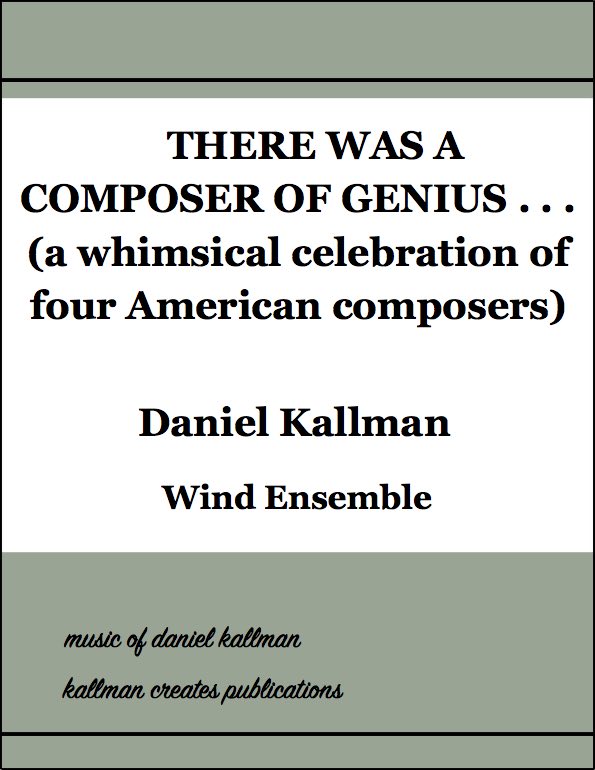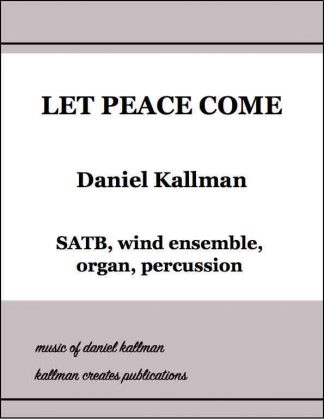Description
![]() Kallman Creates Publications
Kallman Creates Publications
Wind ensemble. Duration: 11’00” The “Sousa” movement is also available separately.
See press release and program notes below.
Listen
View
Press Release
Composer Daniel Kallman Writes Music and Limericks for 29 Bands in 13 States
NORTHFIELD, MN, Dec. 1, 2010 — A recent commission for Minnesota composer Daniel Kallman combines the creation of a musical score with one of his hobbies–coining limericks. The result is a four-movement work for wind ensemble entitled There was a composer of genius . . . (A Whimsical Celebration of Four American Composers) to be premiered in 2010 and 2011 by 29 wind ensembles in 13 states through a consortium commission funded by an Artist Initiative Grant from the Minnesota State Arts Board. The work is an homage to four of Kallman’s favorite American composers: Leonard Bernstein, Duke Ellington, Charles Ives and John Philip Sousa. Each movement is introduced by the recitation of two limericks highlighting prominent stylistic characteristics of one of the composers. These characteristics are mirrored in the music, along with a few well-known musical quotations. Playful extra-musical effects add to the whimsy, especially in the Sousa movement, where a number of instrumentalists vie for the piccolo solo.
Kallman’s new work was premiered on November 8 by the Coe College Concert Band of Cedar Rapids, Iowa. The Burnsville High School Concert Band will present the Minnesota premiere on Thursday, December 16, 2010, at 7:00 p.m. at Burnsville Senior High School, 600 East Highway 13, Burnsville, Minnesota. Other ensembles in the consortium include: The Concordia Band, Concordia College, Moorhead, Minnesota; Wake Forest University Wind Ensemble, Winston-Salem, North Carolina; Austin Symphonic Band, Austin, Texas; and the University of Massachusetts Wind Ensemble, Amherst, Massachusetts. There was a composer of genius will be performed as part of an all-Kallman concert of wind music at Minnesota State University in Mankato on February 22, 2011 at 7:30 p.m. in the Halling Recital Hall of the Performing Arts Center, 320 Maywood Ave., Mankato, Minnesota.
A resident of Northfield, Minnesota, Kallman works full time composing works for band, choir, and orchestra that are widely performed across North America, Europe and East Asia. He has composed for the National Symphony Orchestra, the Air Force Academy Band, the Hong Kong Children’s Choir, the Minnesota Orchestra, A Prairie Home Companion, as well as numerous college, community and youth ensembles.
The Jig is Up, Kallman’s most popular work for winds, has received hundreds of performances by college, high school, professional and community bands. The Vanishing Snows of Kilimanjaro, (Tribute and Lament for Winds) was commissioned by the Air Force Academy Band for their California tour in March of 2007. Other recent works for band include Streets of Honor, commissioned by the 34th Infantry Division Band of the Minnesota National Guard and a 19-member consortium of college, high school and community bands; and Alyeska: The Great Land, written for the Minnesota Symphonic Winds 2006 tour of Alaska.
Daniel Kallman is a fiscal year 2010 recipient of an Artist Initiative Grant from the Minnesota State Arts Board. This activity is funded, in part, by the Minnesota arts and cultural heritage fund as appropriated by the Minnesota State Legislature with money from the vote of the people of Minnesota on November 4, 2008.
Composer’s Program Notes
There was a composer of genius was written to honor four towering figures in American music: Leonard Bernstein, Charles Ives, Duke Ellington and John Philip Sousa. Each of these composers has a distinctive voice in his own particular genre.
Leonard Bernstein’s genius allowed him to compose fluently not only for the concert stage, but also for film, dance, and musical theater. Known by most everyone for his popular musical, West Side Story, Bernstein was equally adept at incorporating jazz and more traditional “classical” styles into his music. He was also famous worldwide as a conductor, pianist and music educator.
Of the four composers, Charles Ives was the least well known during his lifetime, writing music in a style that had never been heard before. His many innovations, such as combining well known melodies simultaneously in different keys and meters, using notes that are in between the keys you find on the piano, and other wildly experimental techniques, made him a target of critics and public audiences for the few works that were publicly performed during his lifetime. He wrote almost all of his music before he was thirty, and much of it was not heard by others until late in his life or after his death.
Duke Ellington is remembered primarily as the world’s preeminent composer for the jazz orchestra, now commonly referred to as the big band. His talent as a composer and charisma as a band leader attracted some of the very best jazz musicians of his day to play in his ensembles. You’ll hear references to two of those players, saxophonist Johnny Hodges and trumpeter “Bubber” Miley, in one of the limericks.
John Philip Sousa (“The March King”) made his mark by solidifying the form of the military or patriotic march. Like Ellington, he travelled widely throughout America and abroad as a leader of his own band, playing well over 15,000 concerts! The band premiered most of Sousa’s marches, many of which have become standards of the repertoire for wind ensembles throughout the world.
In creating this work, I have enjoyed combining my profession as a writer of music with my hobby as a writer of limericks, a habit I got into when my daughters were younger and we traded them back and forth when email came into our lives. Each movement is preceded by two limericks about the composer, pointing out one or more features of his style which are then mirrored in the music to follow, along with a few well-known musical quotations. During the final movement, the band has a little fun with one of the more popular aspects of Sousa’s most famous march.
This composition will be performed by thirty high school, college, community and military bands in 2010-2011, about half of these performances in the state of Minnesota. I was fortunate to assemble this consortium as a result of a grant from the Minnesota State Arts Board.
It is my hope not only that you will be entertained and educated by what you hear in the limericks and music, but that your curiosity might be sparked to seek out the actual music of these composers for your listening enjoyment.
Daniel Kallman is a fiscal year 2010 recipient of an Artist Initiative Grant from the Minnesota State Arts Board. This activity is funded, in part, by the Minnesota arts and cultural heritage fund as appropriated by the Minnesota State Legislature with money from the vote of the people of Minnesota on November 4, 2008.
Each movement is preceded by two limericks:
I. BERNSTEIN
His mind was crammed full of things sonic,
His youthful ambition was chronic,
His fame came alive
When at twenty five
He led the New York Philharmonic!
This genius we fondly call Lenny
His heart soared with music a plenty
The concert band knows
To be on its toes –
Those changes of meter, so many!
II. IVES
His list’ners could become quite furious,
To critics he was all impervious.
Ives brushed them aside
Made two tunes collide
Now that’s when the audience gets nervious!
Traditional rules don’t apply.
“I don’t understand it!”, we cry.
Yet we must agree
Ives turned out to be
More famous than you or than I.
III. ELLINGTON
Jazz orchestra, that was his thing,
Composing for them he was king.
He’d jive and he’d juke
And thus said the Duke:
“It don’t mean a thing without swing.”
His players were none but the best,
Their solos: a creative quest!
Ol’ Hodges would howl,
and Bubber could growl
Head and shoulders above all the rest!
IV. SOUSA
A band leader, John Philip Sousa
Was truly in touch with his musa.
His bold archetype:
The Stars and the Stripes.
It’s music you just can’t refusa!
America thinks highly of him,
For bands there is no one above him;
John Sousa’s the name,
the march king of fame,
And piccolo players just love him!
Copyright © 2011, Daniel Kallman




